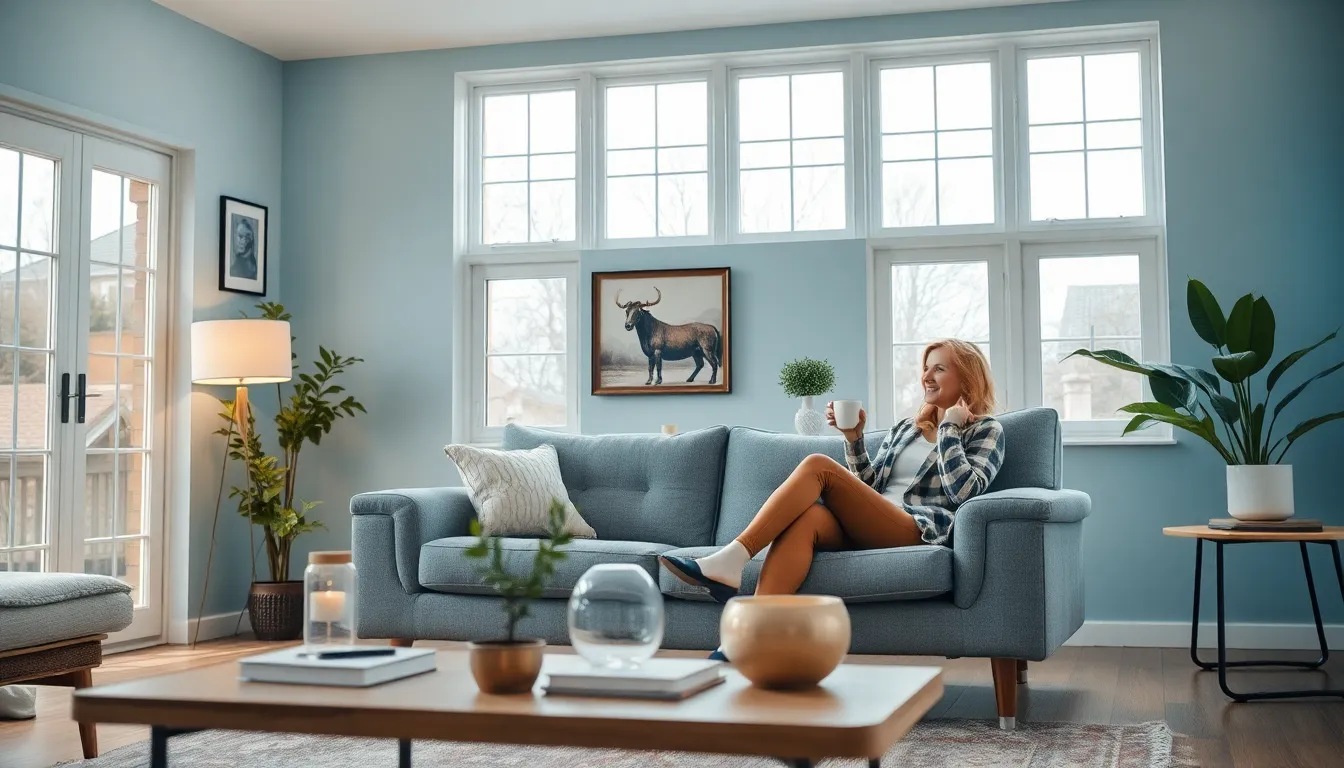Ever walked into a room and felt an instant mood shift? Maybe it was the vibrant colors or that cozy couch that just beckoned for a nap. Interior design isn’t just about aesthetics; it’s a powerful player in the game of mental health. From the calming hues of a serene bedroom to the energizing vibes of a lively workspace, the way a space is designed can make or break one’s mental state.
Imagine living in a space that feels like a warm hug every time you walk in. It’s not just a dream; it’s achievable with the right design choices. As we dive into the fascinating world of interior design and its impact on mental health, get ready to discover how your surroundings can elevate your mood, boost productivity, and even spark joy. Who knew that choosing the right throw pillow could be a step towards a happier life?
Table of Contents
ToggleOverview of Interior Design and Mental Health
Interior design plays a crucial role in shaping mental health. Research shows that spatial arrangements and aesthetic elements significantly influence emotional states. For instance, natural light in a room promotes a sense of calm and well-being. Color choices can create very different atmospheres; blue often induces tranquility, while yellow can stimulate energy and creativity.
Comfort also affects mental clarity and relaxation. Furniture that supports a good posture contributes to reduced stress. The arrangement of elements fosters feelings of spaciousness or confinement, impacting mood. Well-organized areas encourage productivity, whereas cluttered spaces often lead to anxiety.
Plants are another impactful design component. Incorporating greenery not only enhances visual appeal but also improves air quality and elevates mood. Research indicates that nature’s presence in interior spaces fosters feelings of relaxation and enhances overall satisfaction.
Addressing personal preferences within interior design cultivates a supportive environment. Tailoring spaces according to individual needs and tastes fosters ownership and contentment. Engaging all senses through textures, scents, and sounds enhances the living experience.
Finally, mindful design prioritizes mental health, creating a nurturing environment that positively impacts daily life. Thoughtful choices like ergonomic furniture and personalized decor can lead to emotional upliftment. By understanding how various design aspects contribute to mental health, individuals can create spaces that inspire joy and tranquility.
Key Elements of Interior Design

Interior design comprises several key elements that substantially impact mental health. Understanding how these aspects work together is vital for creating nurturing environments.
Color Psychology
Color choices significantly influence emotions and behavior. Blue tones often evoke feelings of calm and tranquility, while warm colors like yellow can stimulate creativity and energy. Selecting softer shades can create a soothing atmosphere, promoting relaxation. Using bold colors strategically can energize a space and uplift spirits. Different cultures also associate colors with varied emotions, which informs personal preferences and approaches to decorating.
Lighting and Ambiance
Natural light enhances mood and well-being, fostering a sense of peace. Using soft, warm lighting encourages relaxation in living areas, while brighter lights enhance focus in workspaces. Dimmer switches allow for adaptable lighting, enabling seamless transitions from active to restful environments. Layering multiple light sources adds depth and richness, creating inviting spaces. Incorporating light fixtures that complement the room’s design enhances aesthetic appeal and mental uplift.
Space Utilization
Effective space utilization maximizes comfort and functionality. Open layouts promote movement and communication, while defined areas can foster focus and productivity. Ergonomic furniture enhances posture, reducing physical stress and preventing discomfort. Clutter-free spaces reduce anxiety, inviting a sense of order and calm. Arranging furniture to encourage social interaction can nurture connections and support interpersonal relationships, promoting overall well-being.
The Role of Mintpaldecor in Enhancing Mental Wellbeing
Mintpaldecor focuses on creating spaces that nurture mental wellbeing through thoughtful design. Color combinations chosen by Mintpaldecor elicit specific emotions. Blue may soothe anxiety, while yellow can spark creativity, making these selections impactful.
Lighting plays a crucial role in the designs they offer. Natural light floods spaces, enhancing mood while fostering a sense of calm. When adaptable lighting options feature in their designs, adaptability leads to inviting atmospheres suitable for various activities.
Furniture selection emphasizes ergonomics. Chairs and desks designed to promote good posture reduce physical stress. Incorporating comfortable seating arrangements invites relaxation, while ensuring spaces remain functional for productivity.
Plants integrate seamlessly into Mintpaldecor’s aesthetic. Adding greenery not only beautifies interiors but also contributes to improved air quality. Such installations elevate mood and serve as a reminder of nature indoors.
Consideration for clutter-free designs appears throughout Mintpaldecor’s approach. Open layouts encourage communication and connection, while designated areas allow for focused tasks. This balance creates an environment where individuals feel at ease and motivated.
Personalization in decor becomes another hallmark of Mintpaldecor’s work. By addressing individual preferences, a greater sense of ownership develops. Unique pieces resonate with those who inhabit the space, fostering contentment and emotional attachment.
Textures, scents, and sounds further form the sensory experience in their designs. Through a combination of tactile materials and pleasant aromas, the atmosphere becomes inviting. Engaging multiple senses contributes to an enriched living experience, reinforcing the connection between design and mental health.
Case Studies and Testimonials
Numerous case studies demonstrate the positive effects of interior design on mental health. A study by the University of California showed that workplaces with ample natural light increased employee satisfaction by 12%. Employees reported feeling less stressed and more productive when surrounded by balanced color palettes and ergonomic arrangements.
Testimonials further illustrate this impact. One homeowner noted that incorporating plants into their living space improved her mood significantly. She mentioned feeling a deeper sense of calm since adding greenery, highlighting that indoor plants enhance air quality and visual appeal.
Additionally, a family’s transition to an open-layout design created a more inviting atmosphere. By reducing physical barriers, family interactions increased, which positively affected their emotional well-being. They shared that the newfound space encouraged collaboration and connection.
Another example involves a mental health clinic that adopted Mintpaldecor principles. Patients responded favorably to the soothing color schemes and natural lighting. According to the clinic’s director, clients reported feeling a sense of comfort and ease during therapy sessions, leading to better engagement.
Long-term effects also emerge from intentional design choices. A couple redesigned their long-neglected basement into a bright, cozy home office. They emphasized that smart design decisions, like choosing calming colors and ergonomic furniture, transformed their workspace and improved overall productivity.
The integration of sensory elements has proven valuable. An elderly resident in a retirement community expressed joy over the incorporation of various textures and scents in her living area. She felt these enhancements sparked fond memories, ultimately enriching her daily experiences.
Interior design plays a crucial role in shaping mental health and overall well-being. By making intentional choices about color, lighting, and space, individuals can create environments that foster relaxation, creativity, and productivity. Incorporating elements like plants and ergonomic furniture not only enhances aesthetics but also promotes comfort and reduces stress.
Mintpaldecor exemplifies how thoughtful design can elevate mood and encourage positive emotional connections to one’s space. Engaging multiple senses through textures, scents, and sounds further enriches the living experience. Ultimately, prioritizing interior design as a component of mental health can lead to a more joyful and fulfilling life.



